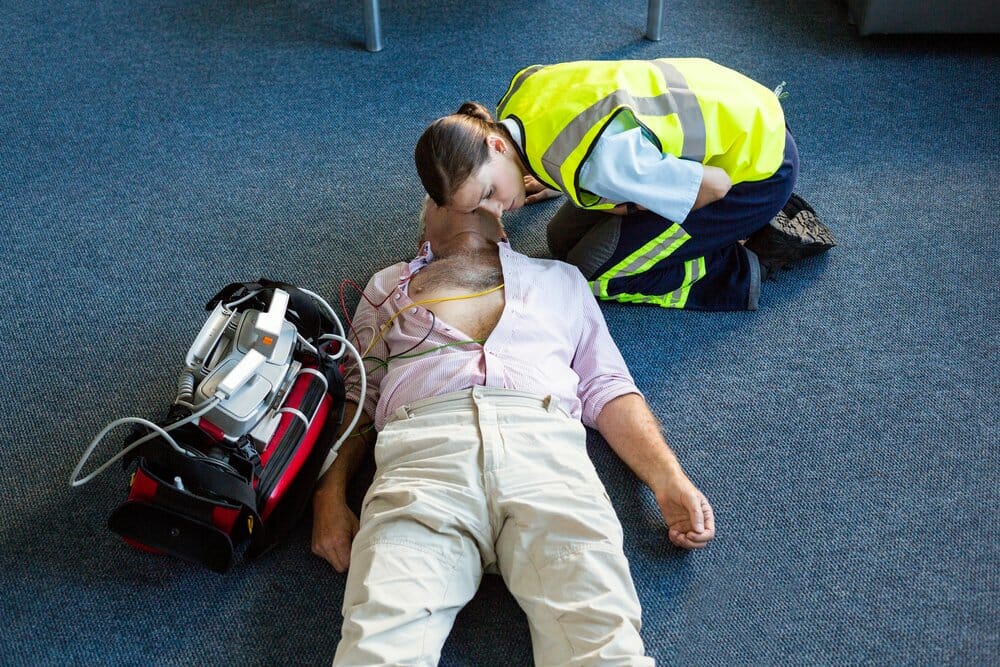
Last Updated On: octubre 16, 2024
Getting your CPR certification online involves learning how and when to give CPR to a person in need. However, there is very little information in the online CPR curriculum that covers when to stop CPR.
Learning the CPR steps helps answer the question, «when should CPR be stopped.» But cardiac arrest emergencies are high pressure, you may need further assistance addressing when to stop CPR. Even if you are CPR certified, studies show that your skills begin to diminish after six months. Staying up to date using articles and other educational resources can keep your CPR skills sharp.
This blog discusses 5 reasons to stop CPR. Even if you’ve got your online certification, there is very little that can prepare you for the real-time emergency of responding to someone in cardiac arrest. This blog helps enables you to put your CPR training to use so you act fast and don’t make mistakes in the field.
If death is apparent, you should not continue performing CPR. CPR is meant for those in cardiac arrest. Instances such as catastrophic injuries, rigor mortis, a body being cold to the touch, and lividity render CPR useless. Bodies will only be cold and have rigor mortis if they have been dead for hours.
If a person is cold to the touch, they are beyond the reach of CPR. However, if you are in a particularly cold environment, you should consider administering CPR. In these cases, you have to weigh your surroundings with other factors such as whether the body is in rigor mortis to determine whether administering CPR is advisable.
Rigor mortis is the third stage of death, and it is caused by chemical changes in the muscles post mortem. These chemical changes cause the victim’s limbs to stiffen. Rigor mortis can set in on victims as soon as four hours after death.
Rigor mortis is a very late sign of death. If you find a victim completely stiff with limbs that do not freely move, it is unfortunately too late to start CPR.
When deciding whether to administer CPR, check the victim’s color to see if they are blue. If they have bluish hues resembling bruises, they may have been deceased for hours. When deciding whether the patient has lividity, you should consider the environment of the body. If it is cold, the victim might have a bluish color to their skin.
Note the difference between bluish hues caused by temperature and the appearance of bruising caused by lividity.
Lividity also always occurs at a person’s center of gravity. Thus, if someone is lying face down, lividity appears on their face and front torso. Clothes and the body position can often hide lividity, but if you notice lividity, the victim is beyond CPR’s reach.
Performing 30 chest compressions repeatedly can be exhausting, and performing CPR the wrong way while you’re fatigued won’t help the victim. That’s why you should trade-off with a bystander if you become fatigued performing CPR. Learn more about chest compression depth through our online guide!
Even if there are no other bystanders with you to perform CPR, it is still advisable to take a break if you become fatigued. If you followed the correct procedure by calling 911, first responders should be on the scene shortly. Stay with the victim until medical attention arrives, and continue performing CPR once you recover.
Performing correct CPR for a limited time by administering chest compressions in the center of the chest, at the proper depth, is more important than performing incorrect hands-only CPR for an extended time.
If you become too tired, you likely won’t be able to keep the victim’s blood flowing with your chest compression. Check for breathing from the patient while you recover and resume once you are more confident in your abilities.
CPR should continue until you see signs of consciousness. Once you notice signs of consciousness such as normal breathing, moving, opening of the eyes, or making sounds, you can stop the CPR process. However, if you stop performing CPR and the victim becomes unresponsive again, you should resume CPR.
Bystanders are not required to administer CPR longer than 30 minutes. However, research has shown more extended resuscitation efforts can aid in brain functionality in cardiac arrest survivors. For example, a toddler regained consciousness after undergoing CPR for over 100 minutes in 2015.
You shouldn’t have to perform CPR for longer than a few minutes because medical responders should arrive on the scene. However, you should take other factors such as lividity and rigor mortis into account if you perform CPR longer than 30 minutes and the victim hasn’t shown any signs of life.
If the scene becomes unsafe, you should try to move yourself and the victim to a safer environment and resume CPR. However, there are instances where moving the victim may be impossible. If this is the case and the situation turns into a life or death situation for you, you should consider your health first before responding to the victim.
There are many factors to take into consideration before stopping CPR. Luckily, if you follow the correct CPR procedure, medical help will arrive before you need to stop CPR.
CPR situations are high-stress, and it can be challenging to keep your composure. Learning the CPR training course curriculum equips you with the knowledge and techniques to respond correctly in these situations. Become more confident in your ability to respond to medical emergencies, consider enrolling in a course for CPR and first aid certification online today!